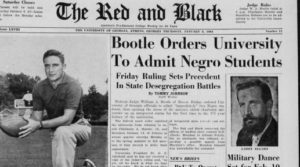At the end of World War II, the United States entered a period of extreme growth and change. Evidence of this growth and change can be seen in the development of the modern Civil Rights Movement. The fight for equality and resistance to discriminatory practices such as segregation of public facilities began in the nineteenth-century when Jim Crow legislation institutionalized segregation based on race. Although resistance to these discriminatory practices did not begin in 1945, the term Civil Rights Movement is often used specifically to refer to the struggles between 1945 and 1970 to end discrimination against African-Americans and to put an end to racial segregation. Several important events occurred during Georgia’s Civil Rights Movement including, the ending of the white primary in 1946, the Albany Movement, and the desegregation of the University of Georgia to name a few. Several Georgians played key leadership roles in the national modern Civil Rights Movement, including Martin Luther King, Jr. and Andrew Young. This primary source set includes five analyzed sources related to Georgia’s modern Civil Rights Movement. It also offers additional primary and secondary sources related to the topic. There are several excellent online sources related to Georgia’s Civil Rights Movement linked on this teaching guide as well.
Click here to view the teacher guide to this primary source set.






You must be logged in to post a comment.